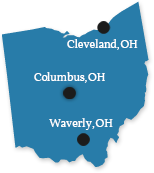The Waverly Elementary School 3rd grader who was injured by a hit-and-run driver in Cleveland in mid-February made news for several reasons. First, the victim was a young child on her way home from school. Second, the driver who injured the child sped around a stopped school bus to do so. And finally, the injury was fairly serious: According to news reports, the child’s mother says she faces months of recovery time.
Unfortunately, hit-and-run accidents (often called hit-skip accidents in Ohio) are far more common than you might think. And you may be surprised by where they happen most frequently. A recent study put Ohio at number eight on a list of states with the highest rate of hit-and-run drivers.
In fact, everything about the likelihood of a hit-and-run accident differs from what you might naturally expect. For example, hit-skip accidents are more common in less populous states. Coastal states generally have a relatively low rate of hit-and-run drivers compared with inland states. And Ohio isn’t the only Midwestern state to make the top 10: Illinois and Iowa are included as well.
Hit-and-Run Accidents Are Particularly Dangerous
Of course, any type of motor vehicle accident, especially a motor vehicle accident involving a pedestrian or a bicyclist, can be dangerous. However, hit-skip accidents can be particularly dangerous because an injured person may be less likely to receive quick medical attention. In one recent year, data from the National Highway Traffic Safety Administration (NHTSA) showed that more than 2,000 people nationwide were killed by hit-and-run drivers. And according to the AAA Foundation for Traffic Safety, hit-and-run fatalities have been increasing at a rate of more than 7% per year since 2009.
The same study shows that most people killed by hit-and-run drivers are pedestrians. However, hit-and-run accidents also impact other drivers, motorcyclists, and bicyclists. The likelihood that a hit-and-run driver will be identified appears to depend in part on the age of the victim. The driver is more likely to be identified after a hit-and-run accident involving a child or an elderly person. Drivers who have injured women are also slightly more likely to be identified than drivers who have injured men. These statistics suggest that community involvement and the likelihood of peer reporting are influenced by the perceived vulnerability of the victim.
Why Do Hit-and-Run Accidents Happen?
Drivers leave the scene of an accident in which someone has been injured or killed for many different reasons. Some of the most common include:
- The driver panics and flees the scene without thinking;
- The driver was speeding, texting, or committing some other violation at the time of the accident;
- The driver did not have a driver’s license or was uninsured;
- The driver was under the influence of drugs or alcohol at the time of the accident.
Occasionally, a hit-and-run driver thinks better of the decision and contacts police after the accident. But many hit-and-run drivers never come forward and only about half are ever identified.
Recovering Compensation After a Hit-and-Run Accident
The victim of a negligent hit-and-run driver is entitled to compensation just like any other person who has been harmed through someone else’s negligence. However, this obviously becomes problematic when the driver has not been identified. Generally, the pursuit of compensation after a hit-and-run accident will take one of two forms:
- Identifying and pursuing compensation from the responsible driver: Of course, it is in the best interests of a driver, pedestrian, bicyclist, motorcyclist, or other person injured by a hit-and-run driver to take steps to identify the responsible party. This process may include advertising or using social media to attempt to reach witnesses to the accident who can provide additional information or having the police department put out a request for tips based on available information about the vehicle and driver. Depending on your circumstances, your car accident attorney may place advertisements, hire an investigator, or otherwise play a role in attempting to identify the person who is responsible for your injury.
- Pursuing a claim under the injured party’s own insurance policy: Ohio law includes unidentified drivers in its definition of an uninsured motorist. That means that if there is evidence of negligence on the part of a hit-and-run driver having caused the victim’s injuries, the victim may make a claim under his or her own uninsured motorist policy. However, uninsured motorist coverage is not required in the state of Ohio. So, this option will only be available to injured parties who have chosen to carry uninsured motorist coverage, and then only to the extent of that coverage.
Generally, it is in the best interests of an Ohio driver to purchase uninsured and underinsured motorist coverage. This coverage may be the best (or even only) means of recovering medical expenses and lost income following a serious accident caused by a driver who does not carry insurance, or who leaves the scene of the accident and is not identified.
Talk to an Experienced Ohio Hit-and-Run Lawyer
If you have been injured by a hit-and-run driver, it is important to speak with an experienced Ohio car accident lawyer as soon as possible. The more time that passes after a hit-and-run accident, the less likely it becomes that the driver will be identified. A local attorney experienced in handling hit-skip cases like the attorneys of Plevin & Gallucci can advise you about the most effective way to pursue compensation in your particular case.
You can schedule a free consultation with one of the experienced attorneys at Plevin & Gallucci right now by calling 855-4PLEVIN or filling out the contact form on this site.

